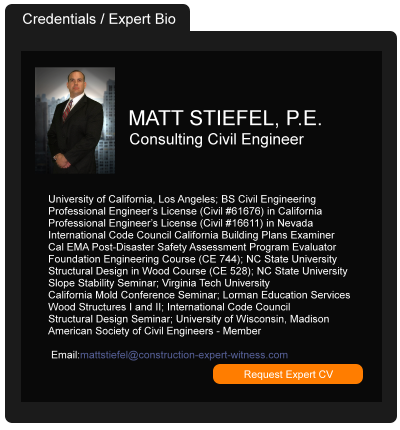Dangerous Condition, Dangerous Precedent: California Supreme Court Expands Scope of Dangerous Condition Liability Involving Third Party Negligent/Criminal Conduct
August 19, 2015 —
R. Bryan Martin, Laura C. Williams, & Lawrence S. Zucker II – Haight Brown & Bonesteel LLPIn Cordova v. City of Los Angeles (filed 8/13/15, Case No. S208130), the California Supreme Court held a government entity is not categorically immune from liability where the plaintiff alleges a dangerous condition of public property caused the plaintiff’s injury, but did not cause the third party conduct which precipitated the accident.
The case arises out of a traffic collision by which the negligent driving of a third party motorist caused another car to careen into a tree planted in the center median owned and maintained by the City of Los Angeles (“City”). Of the four occupants in the car that collided with the tree, three died and the fourth was badly injured. The parents of two of the occupants sued the City for a dangerous condition of public property under Government Code Section 835. The plaintiffs alleged the roadway was in a dangerous condition because the trees in the median were too close to the traveling portion of the road, posing an unreasonable risk of harm to motorists who might lose control of their vehicles.
The City successfully moved for summary judgment, which plaintiffs appealed. On review, the Court of Appeal affirmed holding the tree was not a dangerous condition as a matter of law because there was no evidence that the tree had contributed to the criminally negligent driving of the third party motorist.
Reprinted courtesy of Haight Brown & Bonesteel LLP attorneys
R. Bryan Martin,
Laura C. Williams and
Lawrence S. Zucker II
Mr. Martin may be contacted at bmartin@hbblaw.com
Ms. Williams may be contacted at lwilliams@hbblaw.com
And Mr. Zucker may be contacted at lzucker@hbblaw.com
Read the court decisionRead the full story...Reprinted courtesy of
Congratulations 2019 DE, NJ and PA Super Lawyers and Rising Stars
May 26, 2019 —
White and Williams LLPFifteen White and Williams lawyers have been named by Super Lawyers as a Delaware, New Jersey or Pennsylvania "Super Lawyer" while eight received "Rising Star" designations. Each lawyer who received the distinction competed in a rigorous selection process which took into consideration peer recognition and professional achievement. The lawyers named to this year's Super Lawyer list represent a multitude of practices throughout the firm.
| Super Lawyers 2019 |
|---|
| Attorney | Practice Area |
|---|
| John Balaguer |
PI Defense: Med Mal |
| Kevin Cottone |
PI Defense: Med Mal |
| Thomas Goutman |
Class Action |
| David Haase |
Business Litigation |
| Christopher Leise |
Civil Litigation: Defense |
| Randy Maniloff |
Insurance Coverage |
| David Marion |
Business Litigation |
| Peter Mooney |
Business Litigation |
| Michael Olsan |
Insurance Coverage |
| John Orlando |
General Litigation |
| Wesley Payne |
Insurance Coverage |
| Daryn Rush |
Insurance Coverage |
| Anthony Salvino |
Workers’ Comp |
| Patricia Santelle |
Insurance Coverage |
| Andrew Susko |
Civil Litigation: Defense |
Read the court decisionRead the full story...Reprinted courtesy of
White and Williams LLP
Gen Xers Choose to Rent rather than Buy
February 05, 2014 —
Beverley BevenFlorez-CDJ STAFFDavid Crowe reported in Big Builder that the rate of home purchases by Gen Xers is low due to “challenges” they face caused by the recent recession. According to the article, “The headship rate rises from 16 percent to 48 percent in this age group—known as Generation X—as they finish college and become financially independent. There are 42.5 million people in this age range, and they are followed by 43.9 million in the 15 to 24 age cohort.” However, the recession forced many Gen Xers to postpone “independent living, marriage, and children. Birth rates hit all-time lows in 2012 (half the level of the baby boom), and marriage rates are the lowest they’ve been in a century.”
Unemployment seems to be the major factor in why many Gen Xers are choosing to live with parents or rent instead of buying a home. Crowe stated, “Young adults continue to express the goal of owning their own homes, but many are faced with challenges such as job availability, tight credit standards, inadequate savings for a down payment, student debt, and careers that are likely to require moves.” However, the “employment picture is expected to improve.”
Read the court decisionRead the full story...Reprinted courtesy of
Goldberg Segalla Welcomes William L. Nimick
February 07, 2022 —
Goldberg Segalla LLP(RALEIGH, N.C.)—Goldberg Segalla added William L. Nimick to the firm's Construction Litigation and Counsel group in Raleigh. Nimick was previously with The Law Offices of Stephen R. Paul in Raleigh.
Nimick is an experienced litigator who focuses his practice on counseling and defending corporate entities, insurers, contractors, and subcontractors in a range of liability claims, including those alleging construction defect, personal injury, property damage, premises liability, and more. Nimick draws on a background in civil litigation, personal injury and wrongful death, workers' compensation, and subrogation. He has handled subrogation claims across North Carolina, including construction defects, motor vehicle accidents, product liability lawsuits, and large fire losses.
Nimick earned his bachelor's degree at the University of North Carolina at Wilmington and his juris doctor at the Campbell University Norman Adrian Wiggins School of Law.
About Goldberg Segalla
Goldberg Segalla is a national civil litigation firm with more than 20 offices in 10 states spanning major metro markets across the U.S., providing strategic coverage wherever our clients do business. As a firm of experienced litigators and trial attorneys, Goldberg Segalla's capabilities span business and commercial disputes, employment and labor, insurance coverage, product liability, and more. Today, our more than 400 attorneys are trusted counselors to public and private clients in key sectors and industries including construction and energy, transportation, manufacturing, retail and hospitality, and insurance. To learn more, visit goldbergsegalla.com or follow us on
LinkedIn,
Facebook, and
Twitter.
Read the court decisionRead the full story...Reprinted courtesy of
Supreme Court Rejects “Wholly Groundless” Exception to Question of Arbitrability
February 06, 2019 —
Justin Fortescue - White and Williams LLPIn newly appointed Supreme Court Justice Brett Kavanaugh’s first opinion, the United States Supreme Court held that the “wholly groundless” exception to arbitrability, which some federal courts had relied on as justification to decide questions of arbitrability over the express terms of a contract, was inconsistent with the Federal Arbitration Act and Supreme Court precedent. Based on this decision, where a contract delegates the question of arbitrability to an arbitrator, courts must respect the parties’ contract and refer the question to the arbitrator. Schein v. Archer & White, 586 U.S. __ (2019).
In Schein, Archer & White brought a lawsuit against Henry Schein alleging violations of federal and state antitrust laws and seeking both monetary damages and injunctive relief. The relevant contract between the parties contained an arbitration provision that provided:
“Any dispute arising under or related to this Agreement (except for actions seeking injunctive relief . . .) shall be resolved by binding arbitration in accordance with the arbitration rules of the American Arbitration Association.”
Read the court decisionRead the full story...Reprinted courtesy of
Justin Fortescue, White and Williams LLPMr. Fortescue may be contacted at
fortescuej@whiteandwilliams.com
That Boilerplate Language May Just Land You in Hot Water
December 17, 2015 —
Kevin Brodehl – California Construction Law BlogThe following post originally appeared in my partner
Kevin Brodehl‘s informative blog,
Money and Dirt. If you’re involved in real estate investment, development and/or secured lending in California, it’s a must read. While Kevin’s post below discusses a case involving a real estate purchase agreement, it applies equally to construction contracts, perhaps even more so, since I can’t think of any other type of contract in which indemnity and integration clauses are as common, or as integral.
Almost all real estate purchase and sale agreements contain provisions relating to integration and indemnity.
In the “boilerplate” worldview, these provisions are standard, generic, and basically all the same — integration clauses prohibit extrinsic evidence that would contradict the terms of the agreement, and indemnity clauses force the seller to protect the buyer from third party claims arising after closing.
But a recently published opinion by the California Court of Appeal (Fourth District, Division Three in Santa Ana) — Hot Rods, LLC v. Northrop Grunman Systems Corp. — clarifies that integration and indemnity clauses can have vastly different effects depending on how they are drafted.
Read the court decisionRead the full story...Reprinted courtesy of
Kevin Brodehl, California Construction Law BlogMr. Brodehl may be contacted at
kbrodehl@wendel.com
California Supreme Court Hands Victory to Private Property Owners Over Public Use
June 21, 2017 —
Sean M. Sherlock - Snell & Wilmer Real Estate Litigation BlogIn 1970 the California Supreme Court held that, under certain circumstances, private property owners impliedly dedicate their property to the public if they permit the public to use it. Gion v. City of Santa Cruz (1970) 2 Cal.3d 29. This holding was controversial, and the next year the California Legislature enacted Civil Code section 1009 limiting the public’s ability to permanently use private property through an implied dedication.
In the 40-plus years since then, the lower courts have wrestled with the issue of whether the statute limiting implied dedication applies only to recreational uses by the public, or also to nonrecreational uses. On June 15, 2017, the California Supreme Court issued its unanimous opinion in Scher v. Burke (June 15, 2017, S230104) ___ Cal.4th ___, holding that the limitations on implied dedication apply to nonrecreational as well as recreational uses. The case is significant because it demonstrates that the Supreme Court will apply the plain language of the state’s statutes to uphold private property rights.
Read the court decisionRead the full story...Reprinted courtesy of
Sean M. Sherlock, Snell & WilmerMr. Sherlock may be contacted at
ssherlock@swlaw.com
The Project “Completion” Paradox in California
April 06, 2016 —
Garret Murai – California Construction Law BlogWe’ve written before about why the date of “completion” on a California construction project is important, and why, if I may be blunt, determining that date can be as frustrating as a one-legged man in a game of kickass.
You see, in California the deadline to record a mechanics lien, serve a stop payment notice, or make a payment bond claim – important construction payment remedies the California State Legislature saw fit to help you get paid – often depends on when a project is “completed.” So, for example, the deadline for direct contractors to record a mechanics lien is 90 days from completion of the project.
Read the court decisionRead the full story...Reprinted courtesy of
Garret Murai, Wendel Rosen Black & Dean LLPMr. Murai may be contacted at
gmurai@wendel.com


































































